The global process automation and instrumentation market is valued at USD 1 billion in 2025 and is projected to reach USD 1.7 billion by 2035, growing at a CAGR of 5.5% during the forecast period. This market growth is driven by the rising demand for industrial automation, digitization, and the increasing investments in Industry 4.0 technologies and smart manufacturing projects globally. As per Future Market Insights, ESOMAR-certified in foresight and analytics, despite this growth, challenges such as high upfront implementation costs and complex integration requirements may impact market expansion. The market size is expected to nearly double during this period, reflecting robust long-term growth.
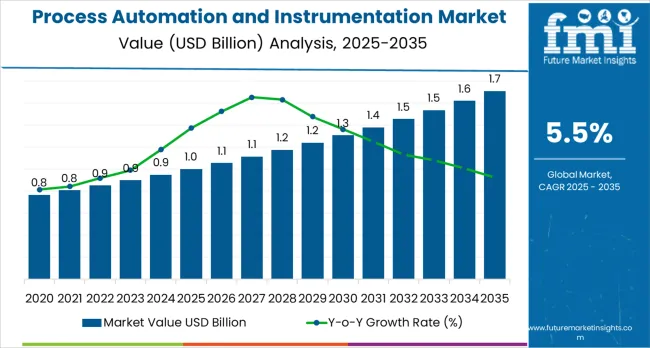
Between 2025 and 2030, the process automation and instrumentation market is projected to expand from USD 1.0 billion to USD 1.3 billion, resulting in a value increase of USD 0.3 billion, which represents 30.0% of the total forecast growth for the decade. This phase of development will be shaped by rising demand for manufacturing efficiency and cost optimization applications, product innovation in digital technologies and IoT-enabled automation systems, as well as expanding integration with artificial intelligence and machine learning capabilities. Companies are establishing competitive positions through investment in advanced control technologies, smart instrumentation solutions, and strategic market expansion across chemical, automotive, and oil &gas applications.
From 2030 to 2035, the market is forecast to grow from USD 1.3 billion to USD 2.0 billion, adding another USD 0.7 billion, which constitutes 70.0% of the ten-year expansion. This period is expected to be characterized by the expansion of specialized automation systems, including advanced predictive maintenance formulations and integrated Industry 4.0 solutions tailored for specific industry requirements, strategic collaborations between automation manufacturers and end-user industries, and an enhanced focus on operational efficiency and digital transformation. The growing emphasis on industrial productivity optimization and smart manufacturing processes will drive demand for high-performance, intelligent process automation and instrumentation solutions across diverse industrial applications.
| Metric | Value |
|---|---|
| Market Value (2025) | USD 1billion |
| Market Forecast Value (2035) | USD 2billion |
| Forecast CAGR (2025-2035) | 5.5% |
The process automation and instrumentation market grows by enabling manufacturers to achieve superior operational efficiency and cost reduction in industrial processes, ranging from small-scale production facilities to large-scale manufacturing complexes. Industrial manufacturers face mounting pressure to improve productivity and reduce operational costs, with process automation solutions typically providing 20-30% improvement in operational efficiency compared to manual processes, making advanced automation systems essential for competitive manufacturing operations. The industrial sector's need for maximum process control and real-time monitoring creates demand for advanced instrumentation solutions that can minimize human error, enhance production consistency, and ensure reliable performance across diverse operational environments. Government initiatives promoting industrial modernization and digital transformation drive adoption in manufacturing, chemical processing, and oil &gas sectors, where automation performance has a direct impact on operational efficiency and safety standards. High initial investment costs and the complexity of achieving seamless integration across different operational systems may limit adoption rates among cost-sensitive manufacturers and developing regions with limited technical expertise.
The market is segmented by operation type, end use, and region. By operation type, the market is divided into automatic, semi-automatic, and others. Based on end use, the market is categorized into chemical, metal &mining, food &beverage, oil &gas, pharmaceutical, pulp &paper, wastewater treatment, automotive, and others. Regionally, the market is divided into North America, Latin America, Western Europe, Eastern Europe, East Asia, South Asia Pacific, and Middle East &Africa.
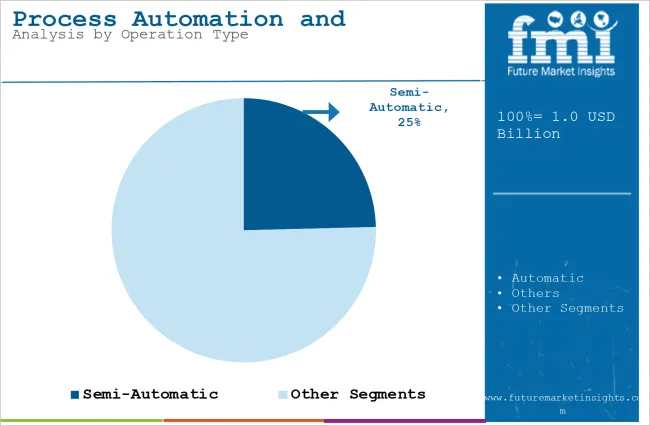
The semi-automatic segment represents the dominant force in the process automation and instrumentation market, capturing approximately 24.6% of total market share in 2025. This advanced operation category encompasses automation formulations featuring superior operational flexibility characteristics, including enhanced human-machine interaction capabilities and optimized performance combinations that enable superior process control and enhanced operational adaptability characteristics. The semi-automatic segment's market leadership stems from its exceptional balance between automation efficiency and human oversight in industrial applications, with systems capable of providing automated process control while maintaining operator intervention capabilities across diverse manufacturing conditions.
The automatic segment maintains a substantial market presence, serving applications that require complete process automation for continuous operation systems. These systems offer reliable performance for high-volume manufacturing applications while providing sufficient automation to meet demanding operational requirements in chemical processing and pharmaceutical manufacturing applications.
Key technological advantages driving the semi-automatic segment include:
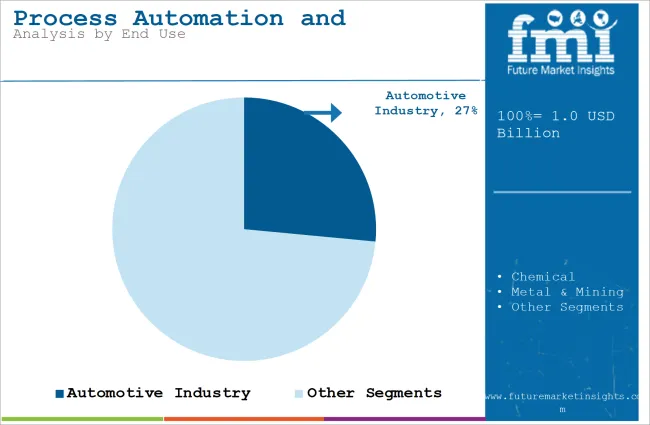
Automotive applications dominate the process automation and instrumentation market with approximately 26.5% market share in 2025, reflecting the critical role of advanced manufacturing systems in serving automotive production demand and supporting precision manufacturing operations. The automotive segment's market leadership is reinforced by increasing production digitization, standardized automation designs for automotive applications, and rising demand for quality control systems that directly correlate with production efficiency and product quality consistency.
The chemical segment represents a significant end use category, capturing substantial market share through specialized requirements for process control systems, continuous monitoring applications, and safety-critical automation operations. This segment benefits from growing demand for automated chemical processing systems that meet stringent safety, reliability, and regulatory compliance requirements in demanding chemical manufacturing applications.
The oil &gas, pharmaceutical, and other industrial segments account for considerable market share, serving specialized manufacturers requiring precise process control solutions for critical applications.
Key market dynamics supporting end use growth include:
The market is driven by three concrete demand factors tied to industrial modernization and efficiency optimization outcomes. First, global Industry 4.0 adoption and digital transformation initiatives create increasing demand for intelligent automation solutions, with industrial digitization projected to accelerate significantly by 2030, requiring specialized automation systems for maximum operational efficiency and data-driven decision making. Second, manufacturing cost reduction and productivity enhancement requirements drive the adoption of advanced process automation technologies, with manufacturers seeking 20-30% improvement in operational efficiency and reduced labor dependency. Third, technological advancements in IoT, artificial intelligence, and machine learning enable more effective and intelligent automation solutions that reduce operational complexity while improving long-term performance and predictive maintenance capabilities.
Market restraints include high upfront investment costs that can impact project feasibility and adoption rates, particularly during periods of economic uncertainty or capital constraints affecting industrial equipment purchases. Technical complexity and integration challenges pose another significant obstacle, as achieving optimal performance across different industrial systems and legacy equipment requires specialized expertise and comprehensive system design, potentially causing implementation delays and increased operational costs. Skills shortage and training requirements create additional challenges for manufacturers, demanding ongoing investment in workforce development and technical capabilities to operate and maintain advanced automation systems effectively.
Key trends indicate accelerated adoption in emerging markets, particularly China, India, and Southeast Asia, where rapid industrialization and manufacturing modernization drive comprehensive automation system development. Technology advancement trends toward edge computing integration with enhanced real-time processing, predictive analytics, and autonomous operation capabilities enable next-generation automation development that addresses multiple operational requirements simultaneously. The market thesis could face disruption if alternative manufacturing technologies or significant changes in industrial processes minimize reliance on traditional process automation solutions.
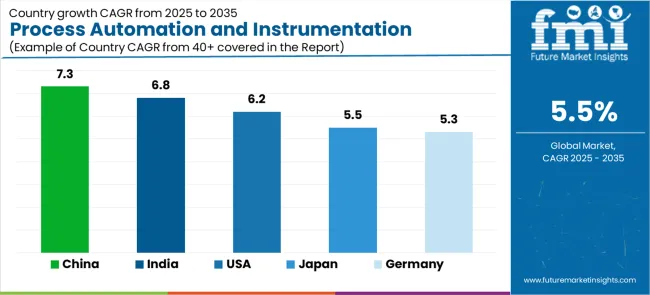
| Country | CAGR (2025-2035) |
|---|---|
| China | 7.3% |
| India | 6.8% |
| USA | 6.2% |
| Japan | 5.5% |
| Germany | 5.3% |
The process automation and instrumentation market is gaining momentum worldwide, with China taking the lead thanks to massive industrial expansion and government-backed manufacturing modernization programs. Close behind, India benefits from growing industrial automation and manufacturing sector development, positioning itself as a strategic growth hub in the South Asia Pacific region. The USA shows strong advancement, where industrial digitization and advanced manufacturing initiatives strengthen its role in the North American automation technology supply chains. Japan demonstrates steady progress through precision manufacturing and technological innovation, signaling commitment to advanced automation adoption in Asian markets. Meanwhile, Germany maintains consistent development through Industry 4.0 implementation and manufacturing excellence, recording steady progress in industrial automation advancement. Together, China and India anchor the global expansion story, while the USA, Japan, and Germany build technological leadership and stability into the market's growth path.
The report covers an in-depth analysis of 40+ countries with top-performing countries highlighted below.
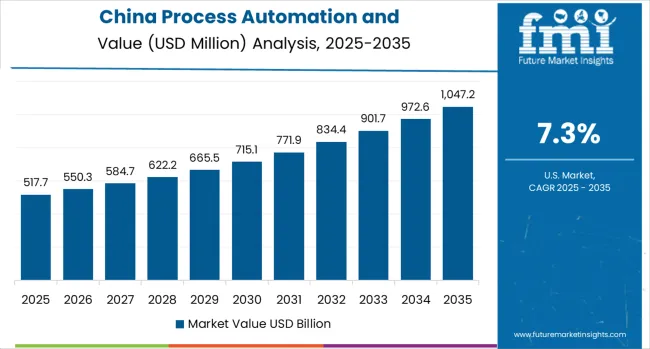
China demonstrates the strongest growth potential in the Process Automation and Instrumentation Market with a CAGR of 7.3% through 2035. The country's leadership position stems from massive industrial expansion projects, government-backed manufacturing modernization programs, and aggressive Industry 4.0 adoption targets, driving the adoption of advanced automation systems. Growth is concentrated in major manufacturing regions, including Guangdong, Jiangsu, Zhejiang, and Shandong, where industrial facilities and manufacturing companies are implementing advanced automation solutions for enhanced operational performance and international competitiveness. Distribution channels through established automation equipment suppliers and direct manufacturer relationships expand deployment across manufacturing facilities and industrial processing centers. The country's industrial development strategy provides policy support for advanced automation system development, including intelligent process control adoption.
Key market factors:
In Mumbai, Delhi, Bangalore, and Chennai, the adoption of process automation and instrumentation systems is accelerating across manufacturing facilities and industrial processing centers, driven by digital transformation targets and government industrial development initiatives. The market demonstrates strong growth momentum with a CAGR of 6.8% through 2035, linked to comprehensive industrial capacity expansion and increasing focus on manufacturing efficiency solutions. Indian manufacturers are implementing advanced automation systems and digital control platforms to enhance operational performance while meeting growing demand for high-quality industrial products in domestic and export markets. The country's industrial modernization programs create continued demand for advanced automation solutions, while increasing emphasis on operational efficiency drives adoption of smart instrumentation technologies and control systems.
The USA market expansion is driven by diverse industrial demand, including automotive manufacturing in Michigan and the Southeast, chemical processing in Texas and Louisiana, and comprehensive industrial modernization across multiple manufacturing regions. The country demonstrates strong growth potential with a CAGR of 6.2% through 2035, supported by federal manufacturing programs and regional industrial development initiatives. American manufacturers face implementation challenges related to legacy system integration and skilled workforce availability, requiring automation upgrade approaches and technology partnership support. Growing manufacturing competitiveness requirements and operational efficiency targets create compelling business cases for process automation system adoption, particularly in industrial regions where operational performance has a direct impact on global competitiveness.
Market characteristics:
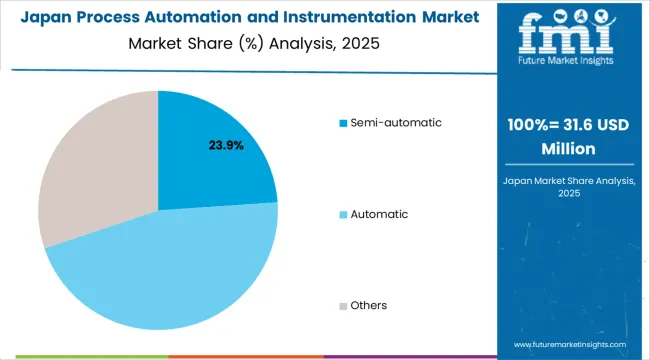
Process automation and instrumentation market in Japan leads in advanced automation innovation based on integration with next-generation manufacturing technologies and sophisticated precision control applications for enhanced operational characteristics. The country shows solid potential with a CAGR of 5.5% through 2035, driven by manufacturing modernization programs and advanced automation initiatives across major industrial regions, including Kanto, Kansai, Chubu, and Kyushu. Japanese manufacturers are adopting advanced automation systems for operational optimization and quality enhancement, particularly in regions with precision manufacturing requirements and advanced processing facilities requiring superior operational performance. Technology deployment channels through established equipment distributors and direct manufacturer relationships expand coverage across manufacturing facilities and industrial processing centers.
Leading market segments:
The process automation and instrumentation market in Germany demonstrates advanced industrial automation based on integration with Industry 4.0 technologies and sophisticated manufacturing applications for enhanced operational characteristics. The country shows steady potential with a CAGR of 5.3% through 2035, driven by manufacturing excellence programs and advanced automation initiatives across major industrial regions, including Bavaria, Baden-Württemberg, North Rhine-Westphalia, and Lower Saxony. German manufacturers are adopting advanced process automation systems for operational optimization and regulatory compliance, particularly in regions with precision engineering requirements and advanced manufacturing facilities requiring superior operational differentiation. Technology deployment channels through established automation providers and direct manufacturer relationships expand coverage across industrial facilities and manufacturing centers.
Leading market segments:
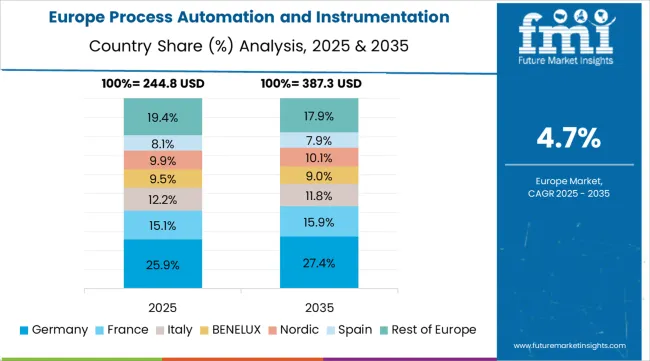
The process automation and instrumentation market in Europe is projected to grow from USD 0.3 billion in 2025 to USD 0.5 billion by 2035, registering a CAGR of 5.2% over the forecast period. Germany is expected to maintain its leadership position with a 28.7% market share in 2025, declining slightly to 28.3% by 2035, supported by its extensive industrial manufacturing infrastructure and major automation centers, including Bavaria, Baden-Württemberg, and North Rhine-Westphalia industrial facilities.
France follows with a 17.9% share in 2025, projected to reach 18.2% by 2035, driven by comprehensive industrial development programs and automation initiatives implementing advanced control technologies. The United Kingdom holds a 15.6% share in 2025, expected to maintain 15.4% by 2035 through ongoing manufacturing system upgrades and industrial automation development. Italy commands a 14.3% share, while Spain accounts for 11.8% in 2025. The Rest of Europe region is anticipated to gain momentum, expanding its collective share from 11.7% to 12.9% by 2035, attributed to increasing process automation adoption in Nordic countries and emerging Eastern European manufacturing facilities implementing advanced automation programs.
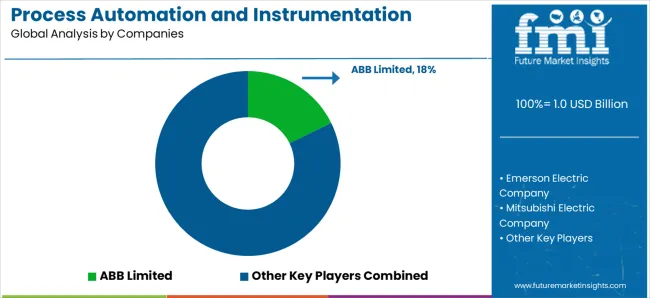
The process automation and instrumentation market features approximately 10-12 meaningful players with moderate to high concentration, where the top three companies control roughly 55-65% of global market share through established technology platforms and extensive industrial automation relationships. Competition centers on technological innovation, system integration capabilities, and comprehensive service offerings rather than price competition alone.
Market leaders include ABB Limited, Emerson Electric Company, and Siemens AG, which maintain competitive advantages through comprehensive automation solution portfolios, global manufacturing networks, and deep expertise in the industrial control and process automation sectors, creating high switching costs for customers. These companies leverage research and development capabilities and ongoing technical support relationships to defend market positions while expanding into adjacent automation applications and emerging industrial markets.
Challengers encompass Rockwell Automation Inc. and Schneider Electric SE, which compete through specialized automation solutions and strong regional presence in key industrial markets. Technology specialists, including Yokogawa Electric Corporation, Honeywell International Inc., and Mitsubishi Electric Company, focus on specific automation configurations or vertical applications, offering differentiated capabilities in process control, instrumentation design, and specialized performance characteristics.
Regional players and emerging automation providers create competitive pressure through cost-effective solutions and rapid customization capabilities, particularly in high-growth markets including China, India, and Southeast Asia, where local presence provides advantages in customer service and technical support. Market dynamics favor companies that combine advanced automation technologies with comprehensive service offerings that address the complete system lifecycle from design development through ongoing operational optimization.
Process automation and instrumentation represent specialized industrial technologies that enable manufacturers to achieve 20-30% improvement in operational efficiency compared to manual processes, delivering superior process control and cost optimization with enhanced safety capabilities in demanding industrial applications. With the market projected to grow from USD 1.0 billion in 2025 to USD 2.0 billion by 2035 at a 5.5% CAGR, these automation systems offer compelling advantages - enhanced operational efficiency, customizable control configurations, and intelligent monitoring - making them essential for manufacturing applications, chemical processing operations, and industrial facilities seeking alternatives to inefficient manual systems that compromise performance through human error and inconsistent operations. Scaling market adoption and technological advancement requires coordinated action across industrial policy, automation standards development, system manufacturers, industrial sectors, and digital technology investment capital.
How Governments Could Spur Local Production and Adoption?
How Industry Bodies Could Support Market Development?
How OEMs and Technology Players Could Strengthen the Ecosystem?
How Suppliers Could Navigate the Shift?
How Investors and Financial Enablers Could Unlock Value?
| Items | Values |
|---|---|
| Quantitative Units | USD 1 billion |
| Operation Type | Automatic, Semi-Automatic, Others |
| End Use | Chemical, Metal &Mining, Food &Beverage, Oil &Gas, Pharmaceutical, Pulp &Paper, Wastewater Treatment, Automotive, Others |
| Regions Covered | North America, Latin America, Western Europe, Eastern Europe, East Asia, South Asia Pacific, Middle East &Africa |
| Country Covered | China, India, USA, Japan, Germany, and 40+ countries |
| Key Companies Profiled | ABB Limited, Emerson Electric Company, Mitsubishi Electric Company, Rockwell Automation Inc., Siemens AG, Schneider Electric SE, Yokogawa Electric Corporation, Honeywell International Inc., Pepperl+Fuchs GmbH, General Electric Company, Hitachi Ltd |
| Additional Attributes | Dollar sales by operation type and end use categories, regional adoption trends across East Asia, North America, and Western Europe, competitive landscape with automation providers and technology integrators, manufacturing facility requirements and specifications, integration with industrial automation and digital transformation systems, innovations in control technology and instrumentation systems, and development of specialized configurations with efficiency and reliability capabilities. |
The global process automation and instrumentation market is estimated to be valued at USD 1.0 billion in 2025.
The market size for the process automation and instrumentation market is projected to reach USD 1.7 billion by 2035.
The process automation and instrumentation market is expected to grow at a 5.5% CAGR between 2025 and 2035.
The key product types in process automation and instrumentation market are semi-automatic , automatic and others.
In terms of end use, automotive segment to command 26.5% share in the process automation and instrumentation market in 2025.






Full Research Suite comprises of:
Market outlook & trends analysis
Interviews & case studies
Strategic recommendations
Vendor profiles & capabilities analysis
5-year forecasts
8 regions and 60+ country-level data splits
Market segment data splits
12 months of continuous data updates
DELIVERED AS:
PDF EXCEL ONLINE
Evaluating Process Automation and Instrumentation Market Share & Provider Insights
Process Pipe Coating Market Size and Share Forecast Outlook 2025 to 2035
Process Spectroscopy Market Analysis - Size, Share, and Forecast Outlook 2025 to 2035
Processed Beef Market Size and Share Forecast Outlook 2025 to 2035
Process Plants Gas Turbine Market Analysis - Size, Share, and Forecast Outlook 2025 to 2035
Competitive Breakdown of Processed Beef Market Share
Market Share Insights for Processed Cashew Providers
Analysis and Growth Projections for Processed Superfruit Market
Processed Meat Market Analysis by Type, Packaging, Meat Type, and Region through 2035
Process Liquid Analyzer Market Growth - Trends & Forecast 2025 to 2035
Analysis and Growth Projections for Processed Cheese Market
Processed Cashew Market Trends – Snack Innovation & Industry Growth 2025 to 2035
Processed Meat Packaging Market Growth & Trends 2024 to 2034
Processed Eucheuma Seaweed Market
Process Analyzers Market
Process Instrumentation Market Growth - Trends & Forecast 2025 to 2035
Processed Fruit and Vegetable Market Analysis - Size, Share, and Forecast Outlook 2025 to 2035
Reprocessed Medical Devices Market Size and Share Forecast Outlook 2025 to 2035
Coprocessor Market
UK Processed Beef Market Size and Share Forecast Outlook 2025 to 2035

Thank you!
You will receive an email from our Business Development Manager. Please be sure to check your SPAM/JUNK folder too.
Chat With
MaRIA